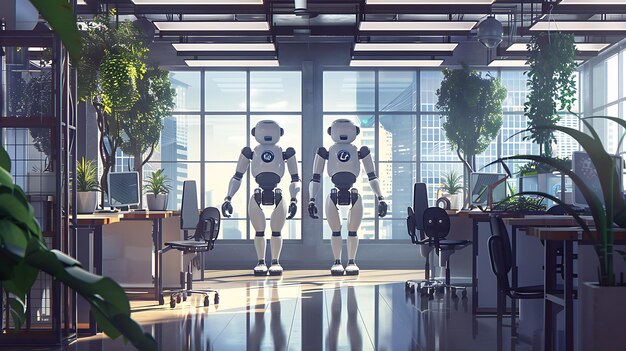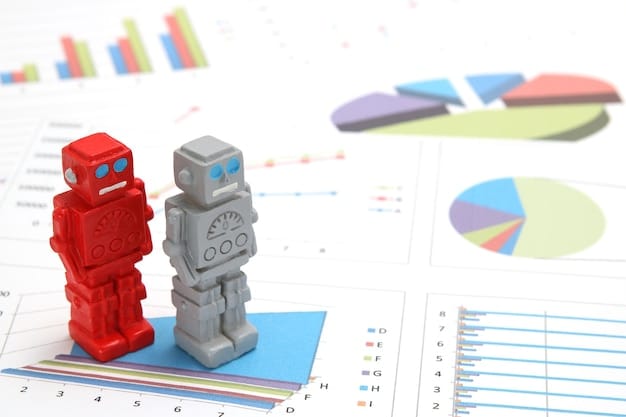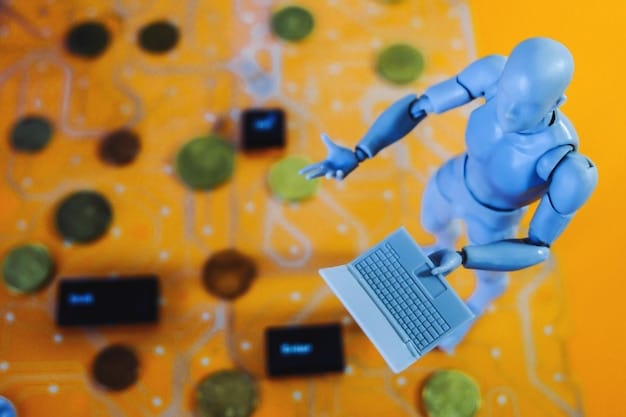AI’s Impact on US Jobs: Which Sectors Face Disruption?

AI’s Impact on US Employment: Which Sectors Face the Biggest Disruption in the Next 3 Months? examines how artificial intelligence is reshaping the job market, identifying vulnerable sectors and offering insights into adapting to this technological shift.
The rapid advancement of artificial intelligence is transforming industries across the United States. Understanding **AI’s Impact on US Employment: Which Sectors Face the Biggest Disruption in the Next 3 Months?** is crucial for both workers and businesses to navigate this evolving landscape.
Understanding AI’s Growing Influence on US Employment
Artificial intelligence is no longer a futuristic concept; it’s a present-day reality reshaping the US employment landscape. Its integration into various industries is accelerating, prompting both excitement about increased efficiency and concern about potential job displacement.
The question isn’t whether AI will impact US employment, but rather how significantly it will do so and which sectors will experience the most pronounced changes in the coming months.
The Rise of Automation and its Impact
Automation, powered by AI, is steadily taking over routine tasks across various sectors. This increased automation brings enhanced productivity and reduced operational costs for businesses.
However, this shift raises significant concerns about the future of jobs that are heavily reliant on repetitive manual or cognitive activities.
- The manufacturing industry is seeing robots and AI systems automating production lines.
- Customer service is increasingly handled by AI-powered chatbots, reducing the need for human agents.
- Data entry and analysis are being streamlined by AI algorithms, impacting administrative roles.
These examples highlight the pervasiveness of AI’s influence, signaling a need for proactive adaptation strategies.
In summary, AI’s growing influence on US employment is undeniable. Automation is rapidly transforming industries, enhancing productivity while also raising valid concerns about potential job displacement. These concerns need to be addressed with strategic adaptation and thoughtful consideration of the future workforce.

Sectors Facing the Greatest Disruption
While AI’s impact is widespread, certain sectors are poised to experience more immediate and significant disruptions. Identifying these vulnerable sectors is crucial for understanding the scope of potential job displacement.
The next three months are expected to be particularly transformative for industries reliant on routine tasks and repetitive processes.
Manufacturing and Production
The manufacturing sector has already witnessed significant automation, but the pace is expected to accelerate. AI-driven robots are becoming more sophisticated, capable of handling intricate tasks previously performed by human workers.
This trend is driven by the desire for increased efficiency, reduced errors, and round-the-clock operation.
Transportation and Logistics
Self-driving vehicles and AI-powered logistics systems are on the cusp of revolutionizing the transportation and logistics industries. As these technologies mature, they threaten jobs in trucking, delivery services, and warehousing.
The potential for cost savings and improved efficiency is a major incentive for companies to adopt these AI-driven solutions.
Customer Service
AI-powered chatbots and virtual assistants are rapidly replacing human customer service representatives. These AI systems can handle basic inquiries, resolve common issues, and provide 24/7 support, often at a fraction of the cost of human agents.
The increasing sophistication of AI allows these systems to provide more personalized and effective customer service, further accelerating their adoption.
- Retail: Checkout processes are being automated with AI-powered kiosks, reducing the need for cashiers.
- Finance: AI algorithms are being used to detect fraud and provide personalized financial advice, impacting roles in banking and investment.
- Healthcare: AI is assisting with diagnosis, treatment planning, and administrative tasks, affecting medical coding and record-keeping positions.
In conclusion, while AI offers many benefits, its impact on various sectors cannot be ignored. Manufacturing, transportation, logistics, and customer service are particularly exposed to the risks of job displacement due to AI-driven automation. Proactive planning and investment in workforce retraining are essential to addressing these challenges.
Strategies for Businesses to Adapt
To effectively navigate the challenges and leverage the opportunities presented by AI, businesses need to adopt proactive and well-defined strategies. These strategies should focus on both preparing the workforce and optimizing operations in the age of AI.
Adaptation is not just about survival; it’s about thriving in a rapidly changing business environment.

Investing in Workforce Retraining and Upskilling
One of the most critical steps businesses can take is investing in workforce retraining and upskilling programs. These programs should focus on equipping employees with the skills needed to work alongside AI systems and take on new roles that emerge as a result of automation.
This involves identifying the skills gaps within the organization and developing targeted training initiatives.
Embracing a Human-AI Collaborative Model
Rather than viewing AI as a replacement for human workers, businesses should embrace a human-AI collaborative model. This involves leveraging AI to automate routine tasks and augment human capabilities, allowing employees to focus on higher-value activities that require creativity, critical thinking, and emotional intelligence.
This collaborative approach can lead to increased efficiency, improved decision-making, and enhanced customer experiences.
Re-evaluating Business Processes
AI implementation will require businesses to rethink current workflows and organisational architectures. Integrating AI successfully necessitates a thorough evaluation of current business processes, with an eye toward procedures that can be simplified or automated.
Fostering Innovation and Experimentation
Businesses should establish a culture of innovation and experimentation, encouraging employees to explore new applications of AI and develop creative solutions to business challenges. This can involve setting up innovation labs, hosting hackathons, and providing employees with the resources and support they need to experiment with AI technologies.
- Healthcare: Focus on using AI to support doctors and nurses.
- Education: Incorporating AI in education to enhance personalised learning experiences, improving educational outcomes.
- Retail: Customer experience enhancement.
In summary, businesses can adapt to AI by investing in upskilling and reskilling initiatives, by embracing a collaborative model that complements human skills and by re-evaluating business processes to incorporate innovation and experimentation. These steps are important for remaining competitive and thriving in the age of AI.
The Role of Government and Education Institutions
While businesses play a crucial role in adapting to AI, governments and educational institutions also have a vital role to play in mitigating the negative impacts of job displacement and ensuring a smooth transition to an AI-driven economy.
Their involvement is essential for creating a supportive ecosystem that enables workers and businesses to thrive in the age of AI.
Investing in Education and Job Training Programs
Governments should invest in education and job training programs that focus on developing skills relevant to the AI-driven economy. This includes STEM skills (science, technology, engineering, and mathematics), as well as soft skills such as critical thinking, problem-solving, and communication.
These programs should be accessible to all, regardless of their background or education level.
Addressing the Skills Gap
Coordinated efforts between sectors can address the growing skills gap. These collaborations will help prepare people for the changing demands of an economy that is being driven by AI. Government and businesses can work together with technical schools and universities to develop appropriate courses that will provide skills for the modern workplace.
Creating a Social Safety Net
Governments should strengthen the social safety net to provide support for workers who are displaced by automation. This can include unemployment benefits, job placement services, and retraining opportunities.
It’s important to ensure that these support systems are adequate to meet the needs of workers who are struggling to find new employment.
Promoting Lifelong Learning
Educational institutions should promote lifelong learning by offering flexible and accessible learning opportunities that cater to the needs of adult learners. This can include online courses, boot camps, and micro-credentials.
- Offering courses on AI and robotics.
- Integrating AI into existing curricula.
- Establishing partnerships with industry.
In conclusion, governments and educational institutions have a vital role to play in ensuring a smooth transition to an AI-driven economy. This includes investing in education and job training programs, adapting labor laws, creating a strong social safety net, and promoting lifelong learning.
Ethical Considerations and Responsible AI Implementation
As AI becomes more prevalent, ethical considerations surrounding its development and deployment are paramount. Responsible AI implementation is not just about avoiding harm; it’s about ensuring that AI is used in a way that benefits society as a whole.
Ethical considerations should be integrated into every stage of the AI lifecycle, from design and development to deployment and monitoring.
Addressing Bias and Discrimination in AI Systems
AI systems can perpetuate and amplify existing biases if they are trained on biased data. It’s critical to address bias in AI systems by carefully curating training data, using algorithms that are designed to mitigate bias, and regularly auditing AI systems for discriminatory outcomes.
Transparency and accountability are essential for building trust in AI systems.
Ensuring Privacy and Data Security
AI systems often rely on large amounts of data, raising concerns about privacy and data security. Businesses and governments must implement robust data protection measures to safeguard personal information and prevent data breaches.
This includes obtaining informed consent from individuals before collecting and using their data, as well as providing them with control over their data.
Promoting Transparency and Explainability
AI systems should be transparent and explainable, meaning that users should be able to understand how they work and why they make certain decisions. This is particularly important in high-stakes applications such as healthcare and criminal justice.
Explainable AI (XAI) techniques can help to make AI systems more transparent and understandable.
- Establishing ethical guidelines for AI development.
- Creating regulatory frameworks that promote responsible AI.
- Promoting public awareness and education about AI ethics.
In summary, it is important to ensure responsible AI implementation in order to protect the interests of society. To do this, we must address issues with bias and discrimination within AI systems as well as guaranteeing data protection and security, promoting explainability and transparency.
Looking Ahead: The Future of Work in an AI-Driven World
The future of work in an AI-driven world is uncertain, but it’s clear that AI will continue to transform industries and reshape the job market. Preparing for this future requires a proactive and adaptable approach.
While AI is expected to automate many routine tasks, it’s also expected to create new jobs and opportunities.
The Rise of the “New Collar” Workforce
As AI takes over routine tasks, there will be a growing demand for workers with skills in areas such as AI development, data science, and robotics. These “new collar” jobs will require a combination of technical skills and soft skills, such as creativity, critical thinking, and communication.
Investing in education and training programs that focus on these skills is essential for preparing the workforce for the future.
The Importance of Adaptability and Lifelong Learning
In an AI-driven world, adaptability and lifelong learning will be more important than ever. Workers will need to be able to learn new skills and adapt to changing job requirements throughout their careers.
This requires a mindset of continuous learning and a willingness to embrace new challenges.
The Potential for Increased Productivity and Innovation
Despite the concerns about job displacement, AI has the potential to significantly increase productivity and innovation. By automating routine tasks and augmenting human capabilities, AI can free up workers to focus on higher-value activities, leading to greater efficiency and creativity.
- Embrace AI as a tool to augment human capabilities.
- Focus on developing skills that complement AI.
- Be prepared to adapt to changing job requirements.
In the face of growing AI capabilities the overall work landscape will shift. The focus in jobs will be on innovation and creativity, requiring people to be agile and prepared for constant learning and adaptation.
| Key Point | Brief Description |
|---|---|
| 🤖 Automation Impact | Manufacturing and customer service face big changes. |
| 📈 Upskilling Strategy | Companies should invest in retraining for their workforce. |
| 💼 New Job Roles | Look for “new collar” jobs requiring AI and analytical skills. |
| 🛡️ Ethical AI Use | Ensure AI system transparency and avoid data bias. |
Frequently Asked Questions
What is the biggest short-term impact of AI on US employment?
▼
In the next three months, customer service and manufacturing are set to see the largest changes as AI-powered systems take over numerous tasks, increasing efficiency but also potentially causing job losses.
▼
Businesses should invest in retraining employees for tasks that AI cannot do, like creative problem-solving and interpersonal roles. Embracing human-AI collaboration can ease this transition.
▼
“New collar” jobs, which include AI developers, data scientists, and robotics technicians, are expected to grow as traditional jobs are automated. Focusing on STEM education can help fill these roles.
▼
Governments should support educational programs and provide a safety net for displaced workers, especially by bolstering job placement schemes and skills training to facilitate re-employment in emerging sectors.
▼
Ethical considerations include guarding against bias in AI algorithms to ensure fair outcomes and protecting worker data privacy to prevent misuse. Transparency and explainability are key to building trust.
Conclusion
The integration of AI into the US job market presents both challenges and opportunities. By understanding which sectors are most vulnerable, implementing proactive adaptation strategies, and addressing the ethical considerations surrounding AI, the US can navigate this technological shift in a way that benefits both workers and businesses.





